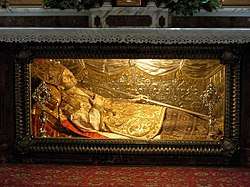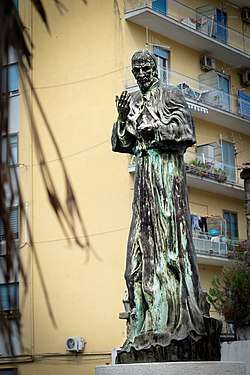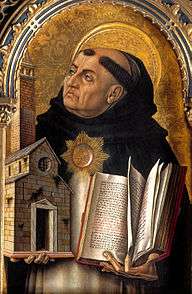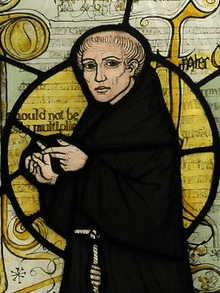Alphonsus Liguori
Alphonsus Liguori (1696–1787), sometimes called Alphonsus Maria de Liguori or Saint Alphonsus Liguori, was an Italian Catholic bishop, spiritual writer, composer, musician, artist, poet, lawyer, scholastic philosopher, and theologian.
Saint Alphonsus Liguori CSsR | |
|---|---|
| Bishop of Sant'Agata de' Goti | |
 | |
| Metropolis | Benevento |
| Diocese | Sant'Agata de' Goti |
| See | Sant'Agata de' Goti |
| Appointed | 14 June 1762 |
| Installed | 20 June 1762 |
| Term ended | 26 June 1775 |
| Predecessor | Flaminius Danza |
| Successor | Onofrio de Rossi |
| Orders | |
| Ordination | 21 December 1726 |
| Consecration | 20 June 1762 by Ferdinando Maria de Rossi |
| Personal details | |
| Born | 27 September 1696 Marianella, Campania, Kingdom of Naples |
| Died | 1 August 1787 (aged 90) Pagani, Campania, Kingdom of Naples |
| Denomination | Roman Catholic |
| Sainthood | |
| Feast day |
|
| Venerated in | Catholic Church |
| Title as Saint | Bishop, Moral Theologian, Confessor and Doctor of the Church |
| Beatified | 15 September 1816 Rome, Papal States by Pope Pius VII |
| Canonized | 26 May 1839 Rome, Papal States by Pope Gregory XVI |
| Patronage | Pagani, Cancello, Naples (co-patron); arthritis, lawyers, confessors, moralists, vocations |
| Shrines |
|
He founded the Congregation of the Most Holy Redeemer, known as the Redemptorists, in November 1732. In 1762 he was appointed Bishop of Sant'Agata dei Goti. A prolific writer, he published nine editions of his Moral Theology in his lifetime, in addition to other devotional and ascetic works and letters. Among his best known works are The Glories of Mary and The Way of the Cross, the latter still used in parishes during Lenten devotions.
He was canonized in 1839 by Pope Gregory XVI and proclaimed a Doctor of the Church by Pope Pius IX in 1871. One of the most widely read Catholic authors, he is the patron saint of confessors.[2][3]
Early years
He was born in Marianella, near Naples, then part of the Kingdom of Naples, on 27 September 1696. He was the eldest of seven children of Giuseppe Liguori, a naval officer and Captain of the Royal Galleys, and Anna Maria Caterina Cavalieri. Two days after he was born, he was baptized at the Church of Our Lady the Virgin as Alphonsus Mary Anthony John Cosmas Damian Michael Gaspard de' Liguori. The family was of noble lineage, but the branch to which Liguori belonged had become somewhat impoverished.[4]
Education
Liguori learned to ride and fence but was never a good shot because of poor eyesight.[4] Myopia and chronic asthma precluded a military career so his father had him educated for the legal profession. He was taught by tutors before entering the University of Naples, where he graduated with doctorates in civil and canon law at 16.[5] He remarked later that he was so small at the time that he was almost buried in his doctor's gown and that all the spectators laughed.[4] When he was 18, like many other nobles, he joined the Confraternity of Our Lady of Mercy with whom he assisted in the care of the sick at the hospital for "incurables".[6]
He became a successful lawyer. He was thinking of leaving the profession and wrote to someone, "My friend, our profession is too full of difficulties and dangers; we lead an unhappy life and run risk of dying an unhappy death".[7] At 27, after having lost an important case, the first he had lost in eight years of practicing law, he made a firm resolution to leave the profession of law.[2] Moreover, he heard an interior voice saying: "Leave the world, and give yourself to me."[5]
Calling to the Priesthood
In 1723, he decided to offer himself as a novice to the Oratory of St. Philip Neri with the intention of becoming a priest. His father opposed the plan, but after two months (and with his Oratorian confessor's permission), he and his father compromised: he would study for the priesthood but not as an Oratorian and live at home.[4] He was ordained on 21 December 1726, at 30. He lived his first years as a priest with the homeless and the marginalized youth of Naples. He became very popular because of his plain and simple preaching. He said: "I have never preached a sermon which the poorest old woman in the congregation could not understand".[5] He founded the Evening Chapels, which were managed by the young people themselves. The chapels were centers of prayer and piety, preaching, community, social activities and education. At the time of his death, there were 72, with over 10,000 active participants. His sermons were very effective at converting those who had been alienated from their faith.
Liguori suffered from scruples much of his adult life and felt guilty about the most minor issues relating to sin.[8] Moreover, Liguori viewed scruples as a blessing at times and wrote: "Scruples are useful in the beginning of conversion.... they cleanse the soul, and at the same time make it careful".[9]
In 1729, Liguori left his family home and took up residence in the Chinese Institute in Naples.[7] It was there that he began his missionary experience in the interior regions of the Kingdom of Naples, where he found people who were much poorer and more abandoned than any of the street children in Naples. In 1731, while he was ministering to earthquake victims in the town of Foggia, Alphonsus claimed to have had a vision of the Virgin Mother in the appearance of a young girl of 13 or 14, wearing a white veil.[7]
Congregation of the Most Holy Redeemer
On 9 November 1732, he founded the Congregation of the Most Holy Redeemer,[10] when Sister Maria Celeste Crostarosa told him that it had been revealed to her that he was the one that God had chosen to found the congregation. He founded the congregation with the charism of preaching popular missions in the city and the countryside. Its goal was to teach and preach in the slums of cities and other poor places. They also fought Jansenism, a heresy that preached an excessive moral rigorism: "the penitents should be treated as souls to be saved rather than as criminals to be punished". He is said never to have refused absolution to a penitent.[5]
A gifted musician and composer, he wrote many popular hymns and taught them to the people in parish missions. In 1732, while he was staying at the Convent of the Consolation, one of his order's houses in the small city of Deliceto in the province of Foggia in Southeastern Italy, Liguori wrote the Italian carol "Tu scendi dalle stelle" ("From Starry Skies Descending") in the musical style of a pastorale. The version with Italian lyrics was based on his original song written in Neapolitan, which began Quanno nascette Ninno (When the child was born). As it was traditionally associated with the zampogna, or large-format Italian bagpipe, it became known as Canzone d'i zampognari the ("Carol of the Bagpipers").[11]
Bishop of Sant' Agata de Goti
Liguori was consecrated Bishop of Sant'Agata dei Goti in 1762.[10] He tried to refuse the appointment by using his age and infirmities as arguments against his consecration. He wrote sermons, books, and articles to encourage devotion to the Blessed Sacrament and the Blessed Virgin Mary. He first addressed ecclesiastical abuses in the diocese, reformed the seminary and spiritually rehabilitated the clergy and faithful. He suspended those priests who celebrated Mass in less than 15 minutes and sold his carriage and episcopal ring to give the money to the poor. In the last years of his life, he suffered a painful sickness and a bitter persecution from his fellow priests, who dismissed him from the Congregation that he had founded.[5]
Death

In 1775, he was allowed to retire from his office and went to live in the Redemptorist community in Pagani, Italy, where he died on 1 August 1787.
Veneration and legacy

He was beatified on 15 September 1816 by Pope Pius VII and canonized on 26 May 1839 by Pope Gregory XVI.[12][13]
In 1949, the Redemptorists founded the Alphonsian Academy for the advanced study of Catholic moral theology. He was named the patron of confessors and moral theologians by Pope Pius XII on 26 April 1950, who subsequently wrote of him in the encyclical Haurietis aquas.
Works
Overview
Liguori was a prolific and popular author.[10] He was proficient in the arts, his parents having had him trained by various masters, and he was a musician, painter, poet and author at the same time. Liguori wrote 111 works on spirituality and theology.[14] The 21,500 editions and the translations into 72 languages that his works have undergone attest to the fact that he is one of the most widely-read Catholic authors.
His best known musical work is his Christmas hymn Quanno Nascetti Ninno, later translated into Italian by Pope Pius IX as Tu scendi dalle stelle ("From Starry Skies Thou Comest").
A strong defender of the Catholic Church, Liguori said:
To reject the divine teaching of the Catholic Church is to reject the very basis of reason and revelation, for neither the principles of the one nor those of the other have any longer any solid support to rest on; they can then be interpreted by every one as he pleases; every one can deny all truths whatsoever he chooses to deny. I therefore repeat: If the divine teaching authority of the Church, and the obedience to it, are rejected, every error will be endorsed and must be tolerated." [15][16]
Moral theology
| Part of a series on |
| Catholic philosophy |
|---|
   |
| Ethics |
|
| Schools |
|
| Philosophers |
|
Postclassical
|
|
Modern
|
|
Contemporary
|
|
|
Liguori's greatest contribution to the Catholic Church was in the area of moral theology. His masterpiece was The Moral Theology (1748), which was approved by the Pope himself[5] and was born of Liguori's pastoral experience, his ability to respond to the practical questions posed by the faithful and his contact with their everyday problems. He opposed sterile legalism and strict rigorism. According to him, those were paths closed to the Gospel because "such rigor has never been taught nor practiced by the Church". His system of moral theology is noted for its prudence, avoiding both laxism and excessive rigor. He is credited with the position of Aequiprobabilism, which avoided Jansenist rigorism as well as laxism and simple probabilism. Since its publication it has remained in Latin, often in 10 volumes or in the combined 4-volume version of Gaudé. It saw only recently its first publication in translation, in an English translation made by Ryan Grant and published in 2017 by Mediatrix Press. The English translation of the work is projected to be around 5 volumes.[17]
Mariology
His Mariology, though mainly pastoral in nature, rediscovered, integrated and defended that of St Augustine of Hippo, St Ambrose of Milan and other fathers; it represented an intellectual defence of Mariology in the 18th century, the Age of Enlightenment, against the rationalism to which contrasted his fervent Marian devotion.[18]
Other works
- Great Means of Salvation and of Perfection[21]
- The Way of Salvation and of Perfection[22]
- The Way of the Cross,
- The History of Heresies and Their Refutation or The Triumph of the Church,
- The Council of Trent or "St. Alphonsus on the Council of Trent",
- Truth of the Faith ("Verita della Fede" there is no known English translation of this book from the Italian),
- Preparation for Death,
- The Incarnation, Birth and Infancy of Jesus Christ[23]
- The Holy Eucharist[24]
- Uniformity with God's Will (pamphlet)[25]
- Victories of the Martyrs[26]
See also
- Élisabeth Eppinger
- Index of Catholic Church articles
- Mental prayer
- Saint Alphonsus Liguori, patron saint archive
- Teresa of Ávila
References
- Calendarium Romanum (Libreria Editrice Vaticana 1969), p. 99
- Miller, D.F. and Aubin, L.X., St. Alphonsus Liguori, Tan Books, 2009, ISBN 9780895553294
- Lives of St. Alphonsus Liguori (from "Vita di S. A. M. de Liguori"), St. Francis de Girolamo (from "Vita del B. Francisco di Girolamo dal Padre L. degli Oddi"), St. John Joseph of the Cross (from "Compendio della vita di Giangiuseppe, data in luce dal Postulatore della causa"), St. Pacificus of San Severino (from "Compendio della vita del B. Pacifico"), and St. Veronica Giuliani (from "Vita della B. Veronica Giuliani, da F. M. Salvatori"); whose canonization took place on Trinity Sunday, May 26th, 1839. C. Dolman. 1839.
- Castle, Harold (2007). "St. Alphonsus Liguori". The Catholic Encyclopedia. New Advent. Archived from the original on 5 July 2007. Retrieved 9 August 2007.
- Fr. Paolo O. Pirlo, SHMI (1997). "St. Alphonsus Liguori". My First Book of Saints. Sons of Holy Mary Immaculate – Quality Catholic Publications. pp. 166–167. ISBN 971-91595-4-5.
- "St. Alphonsus Liguori, Our Founder", Redemptorists, Baltimore Province Archived 12 October 2016 at the Wayback Machine
- Tannoja, Antonio. "The life of St. Alphonsus Maria de Liguori" (1855)John Murphy & Co., Baltimore, 1855
- Selected writings by Saint Alfonso Maria de' Liguori, 1999 ISBN 0-8091-3771-2 p. 209
- The true spouse of Jesus Christ: The complete works of Saint Alphonsus de Liguori 1929, Redemptorist Fathers Press, ASIN B00085J4WM, p. 545
- "Saint Alphonsus Maria de Liguori", St. Alphonsus Liguori Parish, Peterborough, Ontario Archived 11 August 2014 at the Wayback Machine
- "Carol of the Bagpipers". The Hymns and Carols of Christmas. Retrieved 11 December 2014.
- Mercy, Member of the Order of; Press, Aeterna (1906). The Life of Saint Alphonsus Liguori. Aeterna Press.
- Miller, Fr D. F.; Aubin, Fr L. X. (1940). St. Alphonsus Liguori: Doctor of the Church. TAN Books. ISBN 978-1-5051-0374-8.
- "Alphonsus Maria de Liguori", Saint Alphonsus Mary de Liguori Parish, Makati City Philippines
- Appendix to his work on the Council of Trent
- Muller, Michael. The Catholic Dogma: Extra Ecclesiam Nullus Omnino Salvatur.
- "1st English Translation of St. Alphonsus Liguori's Moral Theology". Mediatrix Press.
- P Hitz, Alfons v. Liguori, Paterborn 1967, p. 130.
- Liguori, Alphonsus, The Glories of Mary, New York: P.J. Kenedy & Sons, 1888. Reprint: Rockford, Ill.: TAN Books, 1968.
- Liguori, Alphonsus. The True Spouse of Jesus Christ, Eugene Grimm, ed., Benziger Brothers, New York, 1888
- Liguori, Alphonsus. Great Means of Salvation and of Perfection, Eugene Grimm ed., Benziger Brothers, New York, 1886
- Liguori, Alphonsus. The Way of Salvation and of Perfection, Eugene Grimm ed., Benziger Brothers, New York, 1887
- Liguori, Alphonsus. The Incarnation, Birth and Infancy of Jesus Christ, Eugene Grimm ed., Benziger Brothers, New York, 1886
- Liguori, Alphonsus. The Holy Eucharist, Eugene Grimm ed., Benziger Brothers, New York, 1887
- Liguori, Alphonsus (1755). Uniformity with God's Will. Grand Rapids, MI: Christian Classics Ethereal Library. ISBN 978-0895550194.
- Liguori, Alphonsus. Victories of the Martyrs, Eugene Grimm ed., Benziger Brothers, New York, 1887
![]()
External links
| Wikiquote has quotations related to: Alphonsus Liguori |
| Wikimedia Commons has media related to Alphonsus Maria de Liguori. |
| Wikisource has the text of the 1911 Encyclopædia Britannica article Liguori, Alfonso Maria dei. |
- Works by or about Alphonsus Liguori at Internet Archive
- Works by Alphonsus Liguori at LibriVox (public domain audiobooks)

- Saints Books, E-Book Library of the Works of St. Alphonsus Maria de Liguori
- Founder Statue in St Peter's Basilica
- Free scores by Alphonsus Liguori in the Choral Public Domain Library (ChoralWiki)
- Liguori, Alphonsus. The Holy Mass, Eugene Grimm ed., Benziger Brothers, New York, 1887
- Liguori, Alphonsus. Preaching, Eugene Grimm ed., Benziger Brothers, New York, 1887
- Liguori, Alphonsus. Dignity and Duties of the Priest, Eugene Grimm ed., Benziger Brothers, New York, 1889
- Free scores by Alphonsus Maria de' Liguori in the Choral Public Domain Library (ChoralWiki)
- "Tu scendi dalle stele", Pavaroti
- "St Alphonsus", St. Alphonsus on Catholic Online